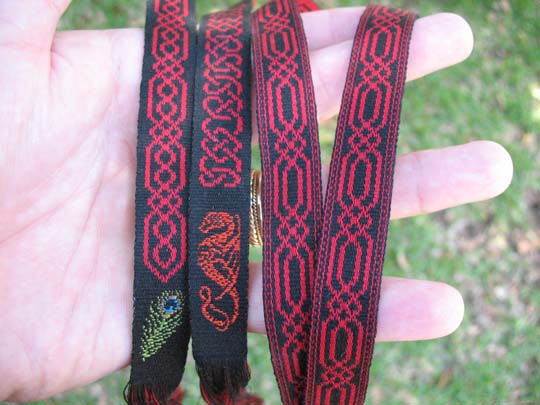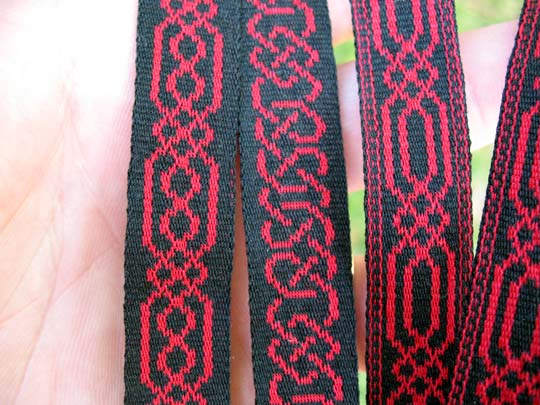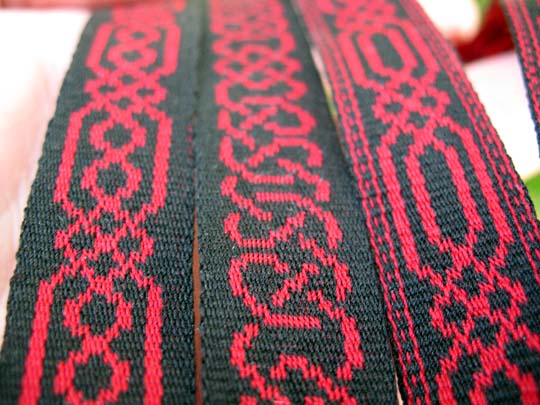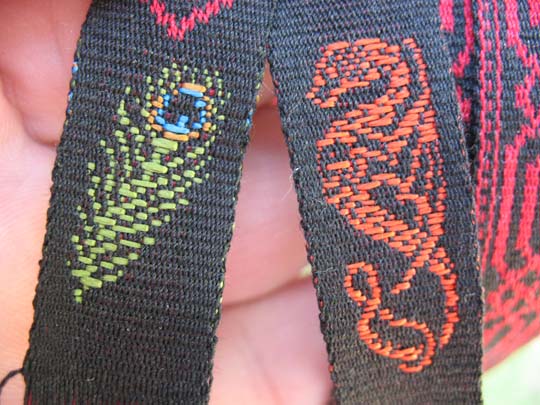Strapwork Ribbons

This is the warp that I’m currently working on. I’ve spliced in a piece of polyester satin ribbon on the loom, so that I can take off these pieces for finishing.

This is Gutermann silk sewing thread. It’s a very tightly twisted 3/100. It’s great for rendering this kind of small detail work. The long piece of strapwork on the right is going to be a neck-band for a name badge; it’s 28″ long in that one pattern. The other two pieces (and the remainder of the warp, about another 2 yards) will be bookmarks.

Closeup of the strapworks. The one in the middle is Celtic-style interlace; the other two are based on Renaissance trim patterns. The Renaissance trims are easy to do, since they follow a simple geometric repeat; the Celtic ones, I have to follow the chart line by line.

Closeup of the brocade designs. The brocading on these pieces is silk embroidery floss; the peacock feather is Kreinik Soie Platte, and the dragon is Zwicky multi-strand floss pulled down to a single strand. For some reason, the digital camera HATES the orange – it makes it look blurry, no matter how finely focused it may actually be.

That is just gorgeous. I especially like the peacock feather. My first though on seeing them was that you were making lanyards, but I’m guessing these have a higher intend purpose than to say, hold a security card for work.
That is just gorgeous. I especially like the peacock feather. My first though on seeing them was that you were making lanyards, but I’m guessing these have a higher intend purpose than to say, hold a security card for work.
and as ever – Stunning!
and as ever – Stunning!
insanely awesome …
insanely awesome …
Well, the short ones will be bookmarks – the long one will pretty much be a lanyard, though. I’m going to weave a lettered name tag, and I’m working with a silver-smithing friend to design the jewelry piece that will frame the name. I want something a little in-your-face for handweavers events – something that says, “Hi, my name is Michael” and at the same time says, “Hi, bow before my stunning virtuosity!”
Well, the short ones will be bookmarks – the long one will pretty much be a lanyard, though. I’m going to weave a lettered name tag, and I’m working with a silver-smithing friend to design the jewelry piece that will frame the name. I want something a little in-your-face for handweavers events – something that says, “Hi, my name is Michael” and at the same time says, “Hi, bow before my stunning virtuosity!”
Gorgeous.
Gorgeous.
WOWOW. I just got my first loom on friday! 🙂 You are such an inspiration!
WOWOW. I just got my first loom on friday! 🙂 You are such an inspiration!
Oh, cool! Let me know if there’s anything I can help with, tablet-weave-wise.
Oh, cool! Let me know if there’s anything I can help with, tablet-weave-wise.
Stunning. Absofuckinlutely stunning!
It makes the band I’m so proud of look like novice work. Oh wait. My band *is* novice work — I don’t have to feel discouraged in the face of such beautiful work. 🙂
Seriously — that is gorgeous and I aspire to do that quality work one of these days. You are a perpetual astonishment and inspiration.
Stunning. Absofuckinlutely stunning!
It makes the band I’m so proud of look like novice work. Oh wait. My band *is* novice work — I don’t have to feel discouraged in the face of such beautiful work. 🙂
Seriously — that is gorgeous and I aspire to do that quality work one of these days. You are a perpetual astonishment and inspiration.
Well, heh. Suggestions on what I should read to get started? I have thread, I have a loom but no idea what to do. lol!
Well, heh. Suggestions on what I should read to get started? I have thread, I have a loom but no idea what to do. lol!
As I said in tablet weaving, those are stunning!
As I said in tablet weaving, those are stunning!
Are you wanting to do tablet weaving, or Inkle weaving? I’m assuming it’s an inkle-type loom? Inkle is more straightforward; tablet has more design options. If you’re doing tablet, I can do a simple basic class in an hour or so.
Are you wanting to do tablet weaving, or Inkle weaving? I’m assuming it’s an inkle-type loom? Inkle is more straightforward; tablet has more design options. If you’re doing tablet, I can do a simple basic class in an hour or so.
I figure I’d start out with inkle weaving to get the hang of things as I’ve never done any of it before and then move onto the tablet if I can. 🙂
I figure I’d start out with inkle weaving to get the hang of things as I’ve never done any of it before and then move onto the tablet if I can. 🙂
Thanks! Yeah, getting to the point of being able to crank out this kind of stuff in sewing thread, was a few years of practice… you can get there if you want, though! I started working with sewing thread on the inkle loom pretty early, before I even touched tablets – it’s just smaller, it’s not more complicated.
Thanks! Yeah, getting to the point of being able to crank out this kind of stuff in sewing thread, was a few years of practice… you can get there if you want, though! I started working with sewing thread on the inkle loom pretty early, before I even touched tablets – it’s just smaller, it’s not more complicated.
it’s just smaller, it’s not more complicated
That’s good to know, though right now it’s still pretty complicated.
I did really well on Saturday though, I got in the groove and started to be able to read the pattern and not make mistakes — or catch them in progress and unmake them. I’ll post pictures soon.
it’s just smaller, it’s not more complicated
That’s good to know, though right now it’s still pretty complicated.
I did really well on Saturday though, I got in the groove and started to be able to read the pattern and not make mistakes — or catch them in progress and unmake them. I’ll post pictures soon.
What kind of pattern are you doing?
I find that a lot of people who have done threaded-in patterns, are amazed to find how simple double-face is; reading the chart line by line is tedious, but it’s SO much simpler to thread up and get going.
What kind of pattern are you doing?
I find that a lot of people who have done threaded-in patterns, are amazed to find how simple double-face is; reading the chart line by line is tedious, but it’s SO much simpler to thread up and get going.
My brain boggles at the level of detail you can get to in this kind of thing. I love knotwork lots and lots, but the dragon and the feather make me want to sit and pet the shiny shiny things for a long time 🙂
My brain boggles at the level of detail you can get to in this kind of thing. I love knotwork lots and lots, but the dragon and the feather make me want to sit and pet the shiny shiny things for a long time 🙂
So lovely!
Did you know that on size 8×0 needles Gutterman silk sewing thread works up to about 35 stitches per inch in stockinette?
So lovely!
Did you know that on size 8×0 needles Gutterman silk sewing thread works up to about 35 stitches per inch in stockinette?
EEp! Where do you find 00000000 needles? I’ve got 0000, but that’s the smallest I could find.
Are you making something at 35 stitches per inch?
EEp! Where do you find 00000000 needles? I’ve got 0000, but that’s the smallest I could find.
Are you making something at 35 stitches per inch?
I got the 8×0 needles at Lacis. I prefer the needles from Bag Lady because they are a little less flexible and have slightly rounder points, but the smallest size there is 6×0. BugKnits sells even smaller needles, but I haven’t tried them out yet.
I entered a knitting competition, How Low Can You Go, 2 years ago. I started out with the 8×0 needles with silk sewing thread, but realized I wouldn’t be able to finish a 4″ x 4″ swatch in time, so I entered a piece on either 5×0 or 6×0 needles with silk top stitching thread (my favorite fingerloop braid thread) that was 25 sts/in.
After that I started a tube at the 35 sts/in gauge that is a permanent part of the Knitting to a Period Gauge class that I teach occasionally in the SCA. It is my “this is smaller than you’ll ever need to work, but try it out just to see what it’s like” sample.
I got the 8×0 needles at Lacis. I prefer the needles from Bag Lady because they are a little less flexible and have slightly rounder points, but the smallest size there is 6×0. BugKnits sells even smaller needles, but I haven’t tried them out yet.
I entered a knitting competition, How Low Can You Go, 2 years ago. I started out with the 8×0 needles with silk sewing thread, but realized I wouldn’t be able to finish a 4″ x 4″ swatch in time, so I entered a piece on either 5×0 or 6×0 needles with silk top stitching thread (my favorite fingerloop braid thread) that was 25 sts/in.
After that I started a tube at the 35 sts/in gauge that is a permanent part of the Knitting to a Period Gauge class that I teach occasionally in the SCA. It is my “this is smaller than you’ll ever need to work, but try it out just to see what it’s like” sample.
The smallest I’ve made a real item was at 18 sts/in. Unfortunately, due to a miscalculation, that over-the-knee stocking didn’t fit, but it makes a great teaching tool. I’m holding off on making another one until I have a clearer idea of what kind of silk was used for stocking knitting in 15th and 16th century Europe, particularly Italy and Spain.
The smallest I’ve made a real item was at 18 sts/in. Unfortunately, due to a miscalculation, that over-the-knee stocking didn’t fit, but it makes a great teaching tool. I’m holding off on making another one until I have a clearer idea of what kind of silk was used for stocking knitting in 15th and 16th century Europe, particularly Italy and Spain.
It’s a threaded in pattern from Candace Crockett’s book. pattern draft 1 on page 68.
This is my 2nd attempt at it. The first was the tangled Australian warp of Doom. Which I fully intend to untangle and make work, now I understand the structure of tablet weaving a lot better than I did.
It’s a threaded in pattern from Candace Crockett’s book. pattern draft 1 on page 68.
This is my 2nd attempt at it. The first was the tangled Australian warp of Doom. Which I fully intend to untangle and make work, now I understand the structure of tablet weaving a lot better than I did.
You must be mellowing. I remember a time when you would have so paranoid about those edges on the peacock strap, you would have never actually photographed it.
Teasing ya…I love the peacock feather…nice touch.
You must be mellowing. I remember a time when you would have so paranoid about those edges on the peacock strap, you would have never actually photographed it.
Teasing ya…I love the peacock feather…nice touch.
Those are beautiful. You are so talented!
Those are beautiful. You are so talented!
Hee. Actually, I looked back at some of my old pieces – the edges aren’t that much neater, I just didn’t have a high-power macro.
Hee. Actually, I looked back at some of my old pieces – the edges aren’t that much neater, I just didn’t have a high-power macro.
The one thing I dislike most about Crockett’s book, is the way she warps. I learned from it, but it was an uphill struggle all the way. If you can possibly warp the cards under tension, you save yourself about 3/4 of the headache.
The one thing I dislike most about Crockett’s book, is the way she warps. I learned from it, but it was an uphill struggle all the way. If you can possibly warp the cards under tension, you save yourself about 3/4 of the headache.